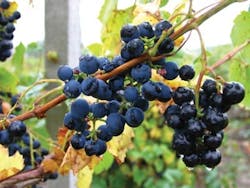Disinfection: UV for Vineyards
About the author: Ken Kershner is regional director – Americas for Aquionics Inc. Kershner can be reached at [email protected] or 859.250.8811.
Brown Brothers Winery in Milawa, Victoria, Australia, has been crafting wines since 1889, with more than 60 wines available for tasting. The third and fourth generations of the family are keeping the tradition alive and have forged a company reputation, locally and abroad, as a wine specialist and winemaking innovator.
Innovation can be found in all facets of wine production at Brown Brothers, including its water treatment. In 2009, the company replaced its existing ultraviolet (UV) disinfection system after experiencing bacteria counts of up to 100 colony-forming units.
System Sizing
Since Brown Brothers’ original UV system was installed, UV system sizing has progressed by leaps and bounds—it now is based on science rather than theory. The original UV system was sized on an average dose—a theoretical calculation that assumes each organism passing through the UV chamber is treated equally. In other words, it assumes perfect flow, mixing and hydraulics. While sizing with an average dose is still done today, it carries a level of risk that for many companies, especially those that make a product destined for dinner tables, is unacceptable and can be avoided.
Technologies such as computation fluid dynamics (CFD) demonstrate that no UV chamber behaves perfectly. As shown in Figure 1, organisms travel different paths through a UV chamber and thus are exposed to different levels of UV-C.
CFD modeling can be used in several ways to benefit UV system sizing:
- To show how an upstream and downstream piping configuration may impact UV system performance. This includes the impact a valve or other device in the pipe run may have on system performance;
- To predict the dose required for a certain organism; and
- To calibrate third-party validation in order to ascertain how an entire model range will perform.
Bioassay Testing
To further enhance the biosecurity of UV, a full bioassay may be performed on all types of UV reactors. A bioassay consists of injecting challenge organisms upstream of the UV system. A count of those organisms then is taken directly before and after the UV system, across a wide range of flows and water quality conditions. The results of the bioassay then are used to develop a validated envelope, which defines the operational range over which the UV system will provide guaranteed performance.
A bioassay can be conducted by a manufacturer, but is more commonly conducted by a third-party engineering firm with no risk of subjective bias toward the UV system’s performance. Two common bioassay guidelines that have been adopted from the municipal water treatment and reuse markets are the U.S. Environmental Protection Agency’s Ultraviolet Disinfection Guidance Manual and the National Water Research Institute’s and Water Research Foundation’s Ultraviolet Disinfection Guidelines for Drinking Water and Water Reuse.
While the language is used loosely, systems subjected to this type of bioassay testing are said to be third-party validated or capable of delivering a reduction-equivalent dose.
Beverage Processing Applications
In the case of Brown Brothers, water treated by the UV system was destined for use in several applications within the winery. This is a common practice, and there are specific areas within wineries or other beverage facilities where UV is commonly used.
Direct contact water. Although municipal water should be free from harmful or pathogenic microorganisms, it should still be treated before entering the process. Water from private sources such as natural springs or boreholes—often used in mineral water—could be contaminated and must be treated. Any water used as an ingredient in food or beverage products, or coming in direct contact with the products, could be a source of contamination. UV can disinfect this water without chemicals or pasteurization and ensures that any chlorine-resistant pathogens, such as Cryptosporidium and Giardia, are inactivated.
Clean-in-place (CIP) rinse water. It is essential that the CIP final rinse water used to flush out foreign matter and disinfecting solutions is microbiologically safe. Fully automated UV disinfection systems can be integrated with CIP rinse.
Filter disinfection. Reverse osmosis (RO) and granular activated carbon (GAC) often are used to filter process water, but can be breeding grounds for bacteria. UV is an effective way to disinfect stored RO- and GAC-filtered water and has been used in the process industries in this way for many years.
Dechlorination. GAC filters also are commonly used to dechlorinate process water, removing the “off” flavors often associated with chlorine disinfection, helping the flavor of the final product to remain free from unwanted flavors or odors. Placing UV systems ahead of GAC filters used for dechlorination improves the performance of the filters and results in longer carbon runs, decreasing operating costs.
Sugar syrups. Sugar syrups can be prime breeding grounds for microorganisms. Although syrups with high sugar content do not support microbial growth, any dormant spores may become active after the syrup has been diluted. Additionally, heat-resistant spores are more commonly found and are not susceptible to the common practice of pasteurization. UV is an effective solution against these organisms.
Liquid sweeteners. Sucrose-based sweeteners also can be breeding grounds for microorganisms. UV systems are available specifically for treating these syrups.
Becoming Bacteria Free
For Brown Brothers Winery, confidence in UV was rebuilt by knowing that innovations in how UV systems were sized had improved since its original purchase.
“Our system has worked perfectly since we installed it in 2009,” said Steve Dows, engineering manager for Brown Brothers. “We routinely get a zero [bacteria] count after the UV.”
Download: Here
